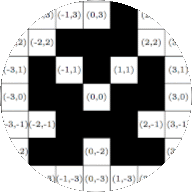The Caesar cipher is an example of a substitution cipher, where one character is replaced by another. Other substitution ciphers use more complicated rules or tables for the encoding of characters. We give an example for another substitution cipher given by an algebraic rule.
We now encrypt a problem with a substitution cipher.
We now decrypt a problem with a substitution cipher.
We now use the encryption function and decryption function from the previous example to encrypt and decrypt a message.
Example 8.34.
Alice and Bob decide to use the encryption function
\begin{equation*}
E:\Z_{27}\to\Z_{27},\;E(c)=(7\cdot c)\fmod 27
\end{equation*}
and the decryption function
\begin{equation*}
D:\Z_{27}\to\Z_{27},\;D(b)=(4\cdot b)\fmod 27
\end{equation*}
for their secure communication. They decide to transmit the messages as sequences of numbers.
Alice wants to send Bob the message:
\begin{equation*}
\mathtt{here{\cspace}i{\cspace}am{\cspace}brain{\cspace}the{\cspace}size{\cspace}of{\cspace}a{\cspace}planet}
\end{equation*}
She begins by encoding the message using the function
\(C\) from
Figure 8.1:
\(8\text{,}\) \(5\text{,}\) \(18\text{,}\) \(5\text{,}\) \(0\text{,}\) \(9\text{,}\) \(0\text{,}\) \(1\text{,}\) \(13\text{,}\) \(0\text{,}\) \(2\text{,}\) \(18\text{,}\) \(1\text{,}\) \(9\text{,}\) \(14\text{,}\) \(0\text{,}\) \(20\text{,}\) \(8\text{,}\) \(5\text{,}\) \(0\text{,}\) \(19\text{,}\) \(9\text{,}\) \(26\text{,}\) \(5\text{,}\) \(0\text{,}\) \(15\text{,}\) \(6\text{,}\) \(0\text{,}\) \(1\text{,}\) \(0\text{,}\) \(16\text{,}\) \(12\text{,}\) \(1\text{,}\) \(14\text{,}\) \(5\text{,}\) \(20\)
Then she encrypts this sequence of numbers with the function \(E\text{:}\)
\(2\text{,}\) \(8\text{,}\) \(18\text{,}\) \(8\text{,}\) \(0\text{,}\) \(9\text{,}\) \(0\text{,}\) \(7\text{,}\) \(10\text{,}\) \(0\text{,}\) \(14\text{,}\) \(18\text{,}\) \(7\text{,}\) \(9\text{,}\) \(17\text{,}\) \(0\text{,}\) \(5\text{,}\) \(2\text{,}\) \(8\text{,}\) \(0\text{,}\) \(25\text{,}\) \(9\text{,}\) \(20\text{,}\) \(8\text{,}\) \(0\text{,}\) \(24\text{,}\) \(15\text{,}\) \(0\text{,}\) \(7\text{,}\) \(0\text{,}\) \(4\text{,}\) \(3\text{,}\) \(7\text{,}\) \(17\text{,}\) \(8\text{,}\) \(5\)
For transmission, she applies the function
\(C^{-1}\) from
Figure 8.1 to obtain the cipher text:
\begin{equation*}
\mathtt{bhrh{\cspace}i{\cspace}gj{\cspace}nrgiq{\cspace}ebh{\cspace}yith{\cspace}xo{\cspace}g{\cspace}dcgqhe}
\end{equation*}
Finally, Alice sends this encrypted message to Bob. After receiving the message, Bob needs to decrypt the message. So, he begins by applying the function \(C\) to change the cipher text to numbers:
\(2\text{,}\) \(8\text{,}\) \(18\text{,}\) \(8\text{,}\) \(0\text{,}\) \(9\text{,}\) \(0\text{,}\) \(7\text{,}\) \(10\text{,}\) \(0\text{,}\) \(14\text{,}\) \(18\text{,}\) \(7\text{,}\) \(9\text{,}\) \(17\text{,}\) \(0\text{,}\) \(5\text{,}\) \(2\text{,}\) \(8\text{,}\) \(0\text{,}\) \(25\text{,}\) \(9\text{,}\) \(20\text{,}\) \(8\text{,}\) \(0\text{,}\) \(24\text{,}\) \(15\text{,}\) \(0\text{,}\) \(7\text{,}\) \(0\text{,}\) \(4\text{,}\) \(3\text{,}\) \(7\text{,}\) \(17\text{,}\) \(8\text{,}\) \(5\)
Then he decrypts this sequence of numbers with the function \(D = E^{-1}\text{:}\)
\(8\text{,}\) \(5\text{,}\) \(18\text{,}\) \(5\text{,}\) \(0\text{,}\) \(9\text{,}\) \(0\text{,}\) \(1\text{,}\) \(13\text{,}\) \(0\text{,}\) \(2\text{,}\) \(18\text{,}\) \(1\text{,}\) \(9\text{,}\) \(14\text{,}\) \(0\text{,}\) \(20\text{,}\) \(8\text{,}\) \(5\text{,}\) \(0\text{,}\) \(19\text{,}\) \(9\text{,}\) \(26\text{,}\) \(5\text{,}\) \(0\text{,}\) \(15\text{,}\) \(6\text{,}\) \(0\text{,}\) \(1\text{,}\) \(0\text{,}\) \(16\text{,}\) \(12\text{,}\) \(1\text{,}\) \(14\text{,}\) \(5\text{,}\) \(20\)
Finally, he applies \(C^{-1}\) to change the numbers back to plain text:
\begin{equation*}
\mathtt{here{\cspace}i{\cspace}am{\cspace}brain{\cspace}the{\cspace}size{\cspace}of{\cspace}a{\cspace}planet}
\end{equation*}

